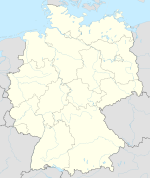Veckerhagen hunting lodge
Coordinates: 51 ° 29 ′ 38 ″ N , 9 ° 36 ′ 21 ″ E
The Veckerhagen Hunting Lodge , also known as Habich's Castle , is a baroque castle in Veckerhagen, a district of the Reinhardshagen municipality in the Kassel district , Hesse . The place is in the southern Weser Uplands on the western bank of the Weser .
location
The privately owned castle (Burgstrasse 1–3) is located between Burgstrasse / Langen Strasse and the Weser, directly on the banks of the Weser; south then are the factories of Habich colors .
history
The old castle
Landgrave Ludwig I of Hesse had a castle surrounded by a moat built on the banks of the Weser between 1430 and 1431, which served as the seat of landgrave ministers and feudal men and to protect the Hessian possessions on the upper Weser. With the end of the Hesse-Paderborn feud in 1472, the military purpose of the old castle was fulfilled. No attention was paid to its preservation and it gradually deteriorated. Fires in 1914 and 1967 largely destroyed the remainder, and today only remains of the wall are left.
Hunting lodge
Next to the old castle, Landgrave Karl von Hessen-Kassel had a three-wing, two-storey (plus attic) hunting lodge built in the Italian Baroque style in 1689 . Possible architects were Paul du Ry or Johann Conrad Giesler .
On September 2, 1721, Landgrave Karl gave the castle and the associated domain to his mistress and confidante Barbara Christine von Bernhold (1690–1756), who had unofficially taken her place after the death of his wife Amalia von Kurland . Even after Karl's death in 1730, she remained in the possession of her property, became an adviser to his son Wilhelm , and was made Countess of the Empire by Emperor Karl VII in 1742 . After her death in 1756, the property returned to Landgrave Friedrich II of Hesse-Kassel in 1770 .
During the first years of the Napoleonic Kingdom of Westphalia , from 1807, the castle was used by King Jérôme Bonaparte .
Paint factory
In 1810 it was sold to the Habich family of manufacturers from Kassel for 2000 Reichstaler . In 1823 the company moved its GE Habich's Söhne paint factory from Kassel to the castle, built manufacturing facilities on the remains of the old castle and produced chemicals and paints there and in the castle. From around 1869 the Habichs also ran an exclusive private school in the castle, in which their children and those of the head forester and a few others were taught by a "seminar-trained teacher".
Part of the old castle used by the paint factory burned down in 1914 and was not rebuilt.
During the Second World War , Junkers Flugzeug- und Motorenwerke set up a branch on the company premises. After the war, the paint factory got back on its feet primarily with the delivery of large quantities of olive for the vehicles of the American troops. In 1967 the still stately remains of the old castle fell victim to another major fire. The remaining foundation walls were used to build workshops and warehouses. Today, about 125 employees painter paints , latex paints , lawn marking paints and colored granules produced.
Veckerhagen Castle and the paint factory next to it are still owned by the Habich family.
Notes and individual references
- ↑ Various years of construction between 1683 and 1694 are suggested in the literature.
- ↑ Uta Löwenstein: Courtly life and courtly representation in Hessen-Kassel in the 18th century, (pdf; 58 kB), p. 40
- ^ Siegfried Lotze: Electorate Hessian Freemasons in Exile: Konnubium and Commerce. A study of the bourgeoisie using the example of the network around the Habich family of manufacturers in the 19th century. Inaugural dissertation to obtain the academic degree of Doctor of Philosophy (Dr. phil.) In the Department of History at the University of Kassel. Kassel, 2009 (p. 71)
- ↑ HNA, August 17, 2010



